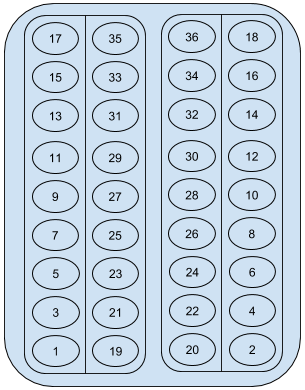Description
Consider 2n rows of the seats in a bus. n rows of the seats on the left and n rows of the seats on the right. Each row can be filled by two people. So the total capacity of the bus is 4n.
Consider that m (m ≤ 4n) people occupy the seats in the bus. The passengers entering the bus are numbered from 1 to m (in the order of their entering the bus). The pattern of the seat occupation is as below:
1-st row left window seat, 1-st row right window seat, 2-nd row left window seat, 2-nd row right window seat, ... , n-th row left window seat,n-th row right window seat.
After occupying all the window seats (for m > 2n) the non-window seats are occupied:
1-st row left non-window seat, 1-st row right non-window seat, ... , n-th row left non-window seat, n-th row right non-window seat.
All the passengers go to a single final destination. In the final destination, the passengers get off in the given order.
1-st row left non-window seat, 1-st row left window seat, 1-st row right non-window seat, 1-st row right window seat, ... , n-th row left non-window seat, n-th row left window seat, n-th row right non-window seat, n-th row right window seat.
 The seating for n = 9 and m = 36.
The seating for n = 9 and m = 36.You are given the values n and m. Output m numbers from 1 to m, the order in which the passengers will get off the bus.
The only line contains two integers, n and m (1 ≤ n ≤ 100, 1 ≤ m ≤ 4n) — the number of pairs of rows and the number of passengers.
Print m distinct integers from 1 to m — the order in which the passengers will get off the bus.
2 7
5 1 6 2 7 3 4
9 36
19 1 20 2 21 3 22 4 23 5 24 6 25 7 26 8 27 9 28 10 29 11 30 12 31 13 32 14 33 15 34 16 35 17 36 18
首先最左边是一个1开始,差为2的等差数列,求出最上层的数字,第二行第一个是
第一行最上层的数字+1,第三行第一个是第二行第一个数字加一,第四行是2开始,差为2的等差数列,然后按照规律输出就行
#include<stdio.h>
//#include<bits/stdc++.h>
#include<string.h>
#include<iostream>
#include<math.h>
#include<sstream>
#include<set>
#include<queue>
#include<map>
#include<vector>
#include<algorithm>
#include<limits.h>
#define inf 0x3fffffff
#define INF 0x3f3f3f3f
#define lson l,m,rt<<1
#define rson m+1,r,rt<<1|1
#define LL long long
#define ULL unsigned long long
using namespace std;
int t;
int n,m;
int sum,ans,flag;
long long b,c,d,e;
long long a[500][500];
int main()
{
cin>>n>>m;
for(int i=0;i<n;i++)
{
a[i][0]=1+i*2;
// cout<<a[i][0]<<endl;
}
a[0][1]=a[n-1][0]+2;
for(int i=1;i<n;i++)
{
a[i][1]=a[i-1][1]+2;
// cout<<a[i][1]<<endl;
}
a[0][2]=a[0][1]+1;
for(int i=1;i<n;i++)
{
a[i][2]=a[i-1][2]+2;
// cout<<a[i][2]<<endl;
}
for(int i=0;i<n;i++)
{
a[i][3]=(i+1)*2;
}
int sum=0;
e=m%4;
for(int i=0;i<n;i++)
{
if(a[i][1]&&a[i][1]<=m)
{
cout<<a[i][1]<<" ";
}
if(a[i][0]&&a[i][0]<=m)
{
cout<<a[i][0]<<" ";
}
if(a[i][2]&&a[i][2]<=m)
{
cout<<a[i][2]<<" ";
}
if(a[i][3]&&a[i][3]<=m)
{
cout<<a[i][3]<<" ";
}
}
return 0;
}